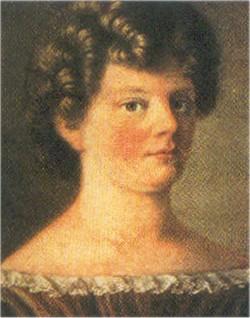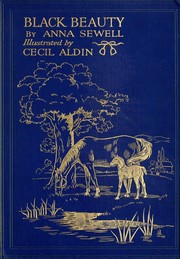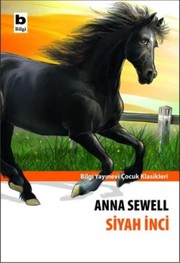"Anna Sewell was born in 1820 and died in 1878. She was lame from childhood and spent most of her life as a semi-invalid living at Brighton where her father had a position as a Bank Manager. Her mother wrote several moral tales in verse for children. Anna wrote only one book, Black Beauty, which was published 1877, and which sold over 100,000 copies in the first twenty years. It has been translated into French, Italian, German and has been described as 'one of themost successful animal stories ever written."
(Biographical note from "Black Beauty", Blackie & Son Ltd., Glasgow, ca 1950s.)
Mary and Anna Sewell
By Diana Kennedy
*This article was originally published in the August 2001 edition of Soul
Search, the journal of The Sole
Society.*
Both Mary Sewell nee Wright and her daughter Anna were authors. Mary, less well known today was a popular author of juvenile best sellers, writing stories with titles such as “Mother’s Last Words”, “Our Father’s Care” and “Thy Poor Brother”. Mary was a deeply religious woman, with a sensitive and artistic nature, who was until 1835 a Quaker. She was also a member of the Anti-Slavery Association. Her daughter Anna was the author of the well known children’s classic ‘Black Beauty’, a fictional autobiography of a thoroughbred horse. Her aim in writing the book was to “induce kindness, sympathy and an understanding treatment of horses”. The book has a strong moral purpose and is said to have been instrumental in the abolition of the cruel practice of using the checkrein . The book was recommended by the Royal Society for the Prevention of Cruelty to Animals.
Mary Wright was born 6th April 1797 at Sutton, Suffolk, the daughter of John Wright a gentleman farmer and Ann nee Holmes. Ann was the daughter of John Holmes of Tivetshall, Norfolk. Mary Wright married Isaac Sewell on 15th June 1819 at Lamas, Norfolk after a five year courtship. Isaac was the youngest of twelve children of William and Hannah Maria nee Fuller was born 25th September 1793 at Great Yarmouth. His father William was the second of eight children of Abraham and Mary Sewell.
Isaac and Mary’s daughter Anna was baptised at Great Yarmouth on 30th March 1820.
A few days after Anna’s birth Isaac discovered that he had been swindled in a business venture, leaving him in financial difficulties. With the help of Quaker Friends the family moved to a little house and shop off Bishopsgate Street in London opposite a gin palace. Unfortunately Isaac had been badly advised and soon after the birth of his son Phillip in 1822, the family found themselves in further financial difficulties. The family then moved to Dalston, where they were to spend the next ten years.
It was at Dalston that Mary Sewell’s first little book was published, a book of verses which were written with the object of inculcating moral virtues in all relations of her life. Mary taught her children at home and writing helped her to earn money to buy books for her children’s education. Later Anna was to attend a day boarding school. Mary trained her children to find glory rather than degradation in work, and work became an outlet for the high spirited Anna. It was a happy time for the family at Dalston, although it was here that returning from school one day Anna fell and sprained both her ankles severely. Despite medical attention Anna became more and more crippled, and was to spend much of her life confined to home. However she was always cheerful and thoughtful towards others, despite her problems.
In 1836 Isaac moved to Brighton with his family to become the manager of the London and County Bank. It was here that her parents hoped to find a cure for Anna. A doctor bled her profusely, but she steadily grew more crippled. She does however write in her journal in 1844 of walks with her friends and visits to London to see art galleries. She herself was a gifted artist. Anna also had a love of nature and delighted in visiting her grandparents at Buxton, just outside Norwich, which fostered her love of the countryside. The census of 1851 shows Anna and her brother Phillip both at Buxton, Norfolk. Anna was staying with her Grandfather John Wright, whilst Phillip was with their Uncle John Wright. Phillip was to inherit the Manor of Brampton from his uncle in 1871 and was able to buy the manor of Buxton his grandparent's place. His two spinster daughters later gave Sewell Park to the corporation of Norwich.
In 1845 Isaac moved his family to Lancing and it was probably here that Anna’s love of horses developed. A pony chaise was purchased and Anna drove her father to and from Shoreham station. The following year Mary took her family to Germany for a holiday, and Anna was left there for treatment that helped her to walk. Isaac retired form the bank in 1857 and in the autumn of that year the family visited Santander in Spain. On their return they settled at Blue Lodge in Wick near Bath and Bristol. It was at Wick that Mary’s main works were published with Anna assisting her mother in the work. ‘Homely Ballads’ was published for private circulation in 1858 but by 1889 40,000 copies had been sold. ‘Mothers Last Words’ a story of two boys kept from evil courses by their mothers last words sold 1,088,000 copies. It had a simplicity of language which made her writing popular. ‘Stories in Verse’ a collection of her poems was published in 1861. The family was at Wick until 1867 when they moved back to Norfolk settling at Old Catton near Norwich.
Anna SewellAnna first mentioned that she was writing Black Beauty in her journal on 6th November 1871. She wrote “I am writing the life of a horse, and getting dolls and boxes ready for Christmas”. In December 1876 she wrote, “I am getting on with my little book ‘Black Beauty’.” By this time Anna was becoming more and more crippled and was confined to the house spending much of her time on a sofa writing in pencil, with her mother making a copy. She wrote “I have been confined to the house and to my sofa, from time to time, when I am able, been writing what I think will turn out a little book, its special aim being to induce kindness, sympathy and an understanding treatment of horses”. Black Beauty was published at the end of 1877 and Anna lived just long enough to hear of its success. She died in April 1878. ‘Black Beauty’ went on to sell over 100,000 copies by 1894 and was translated into French, German, and Italian.
Anna was buried in the Quaker burying ground at Lamas near Norwich. Her father Isaac died 7th November 1878 at Old Catton. Mary died 10th June 1884 and was also buried at Lamas despite having left the Quakers in about 1835 for the Church of England. In 1886 Mary’s ‘Poems and Ballads’ was published in two volumes
374 works Add another?

Most Editions
Most Editions
First Published
Most Recent
Top Rated
Reading Log
Random
Showing all works by author. Would you like to see only ebooks?
Subjects
Children's fiction, Horses, fiction, Horses, England, fiction, Fiction, Juvenile fiction, Animals, treatment, fiction, Black Beauty (Fictitious character), History, Animals, Fairy tales, Large type books, Chevaux, Family, Folklore, New england, fiction, Animal welfare, English language, High interest-low vocabulary books, Readers, Textbooks for foreign speakers, Classic, Fiction, general, Great britain, history, fiction, Literature and fiction, juvenileID Numbers
- OLID: OL25123A
- ISNI: 0000000080844422
- VIAF: 5052475
- Wikidata: Q258741
- Inventaire.io: wd:Q258741
Links outside Open Library
| December 18, 2023 | Edited by bitnapper | Edited without comment. |
| December 18, 2023 | Edited by bitnapper | merge authors |
| December 20, 2022 | Edited by Tom Morris | merge authors |
| August 31, 2022 | Edited by dcapillae | remove wrong names |
| April 1, 2008 | Created by an anonymous user | initial import |










